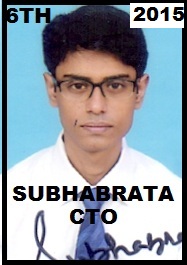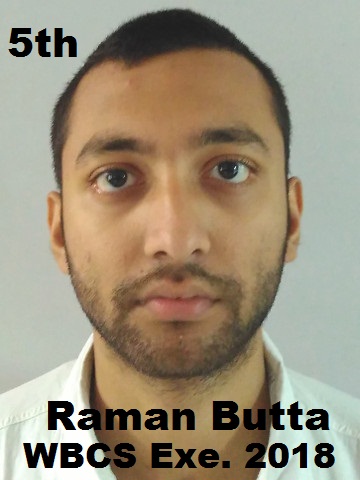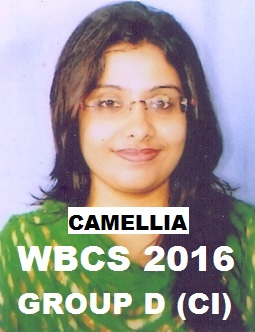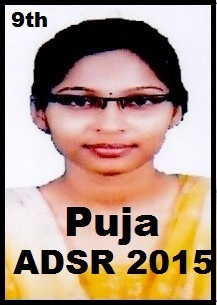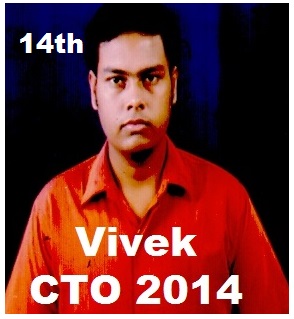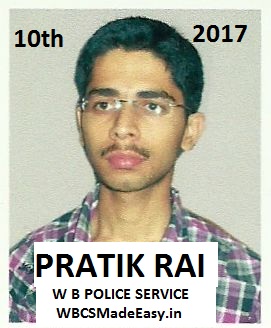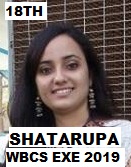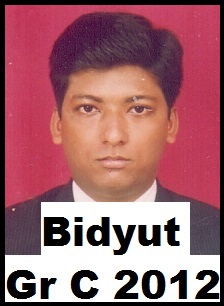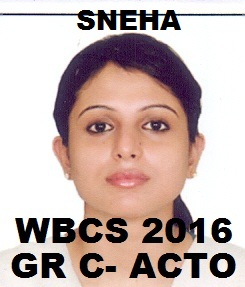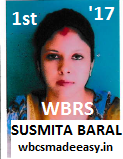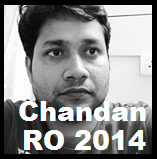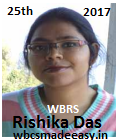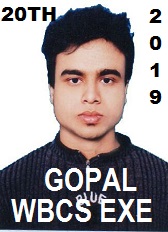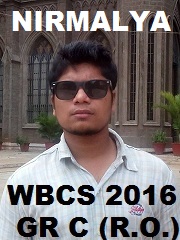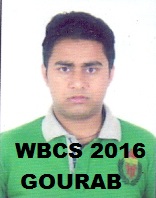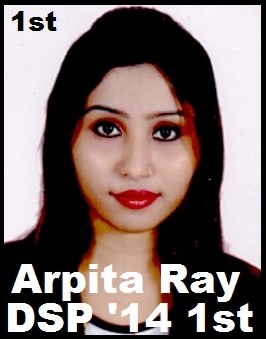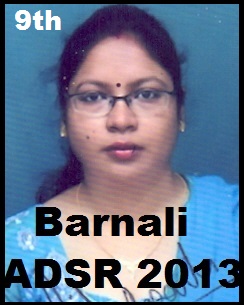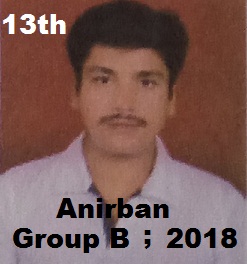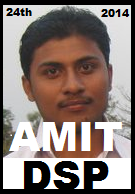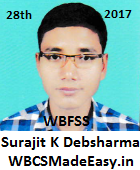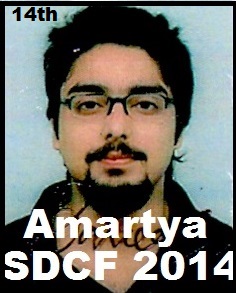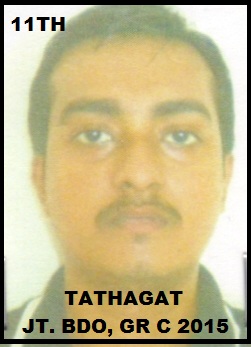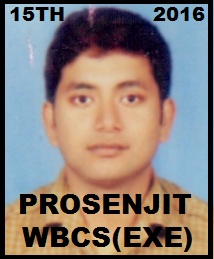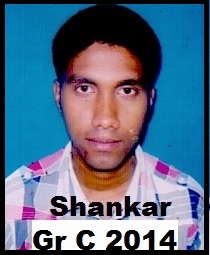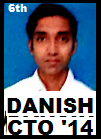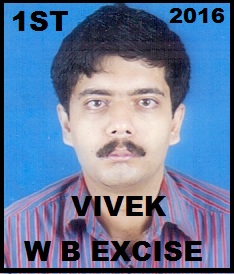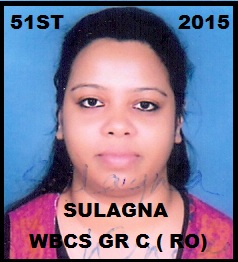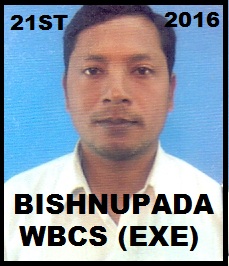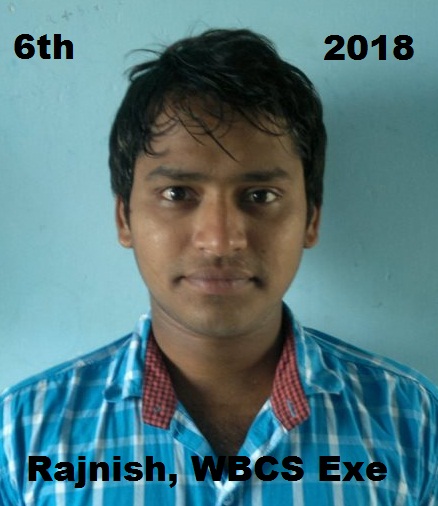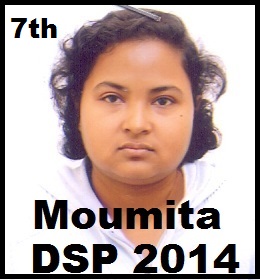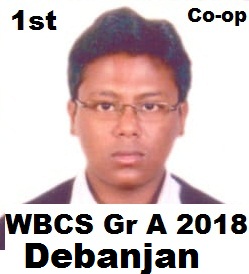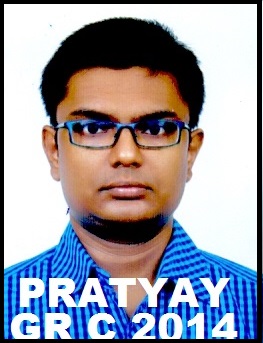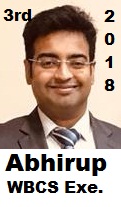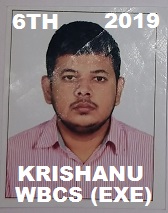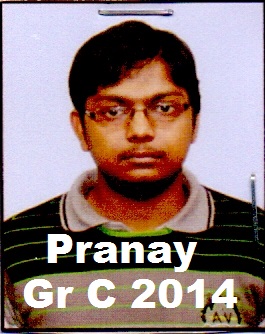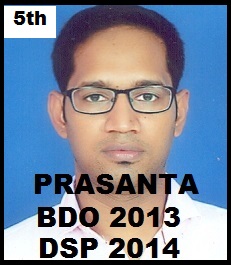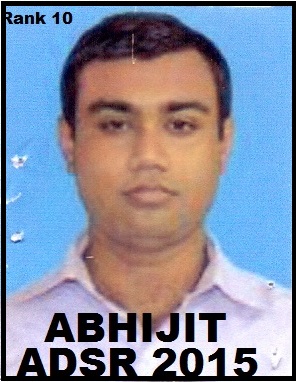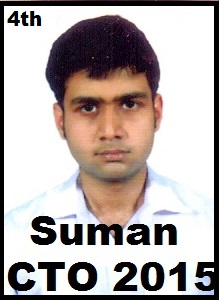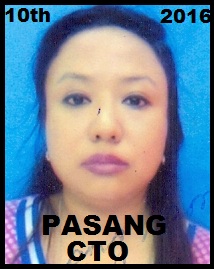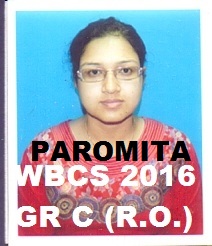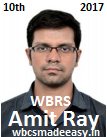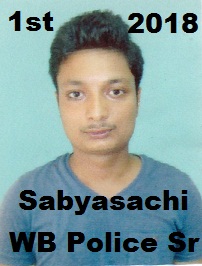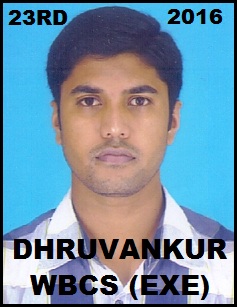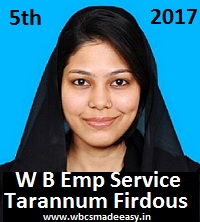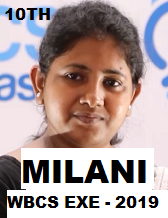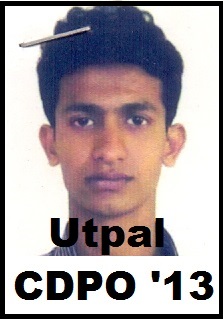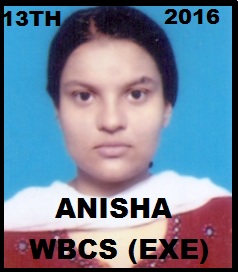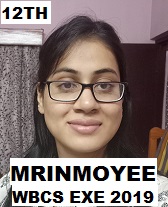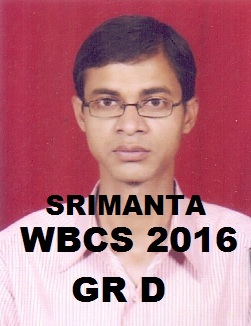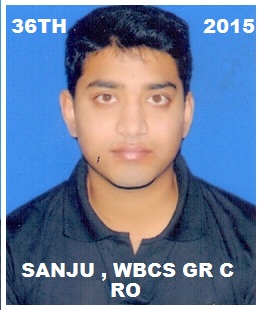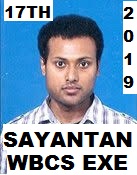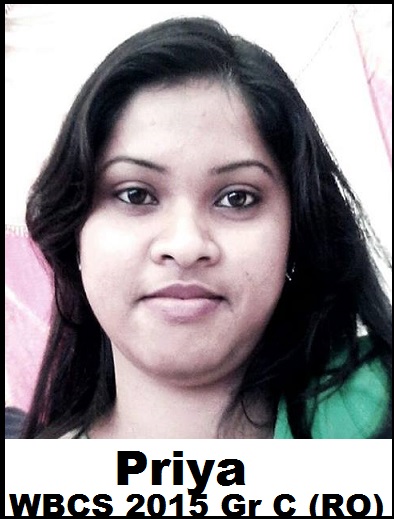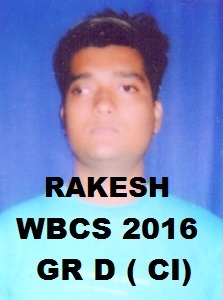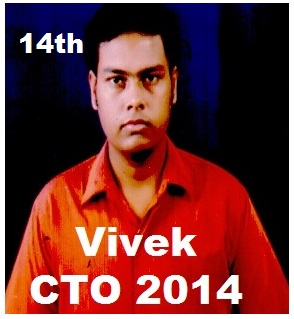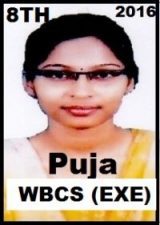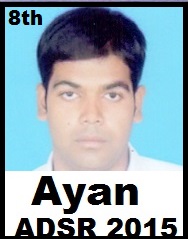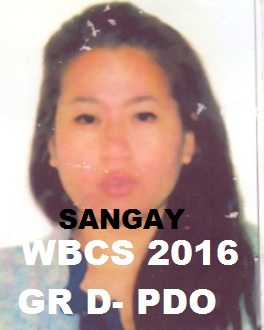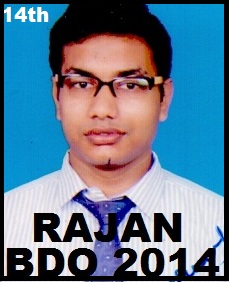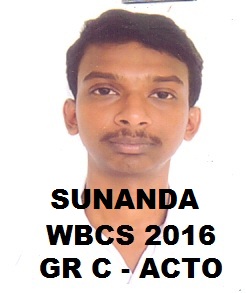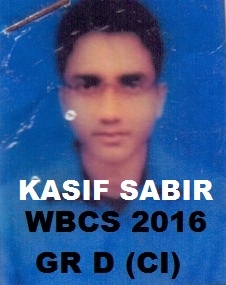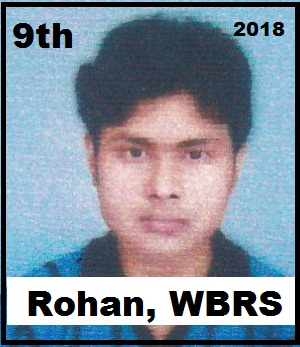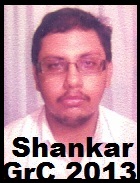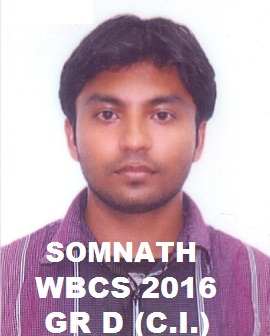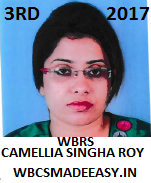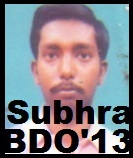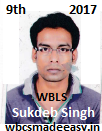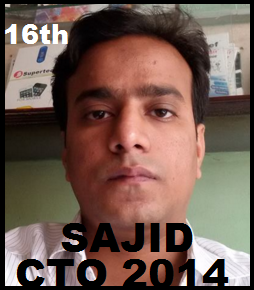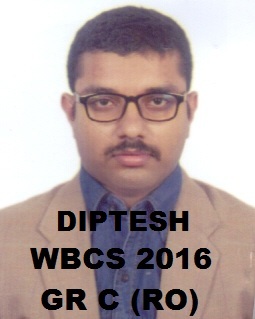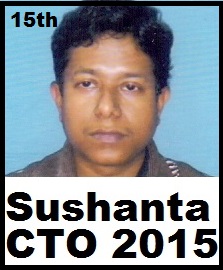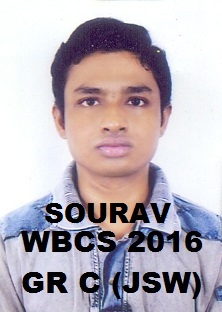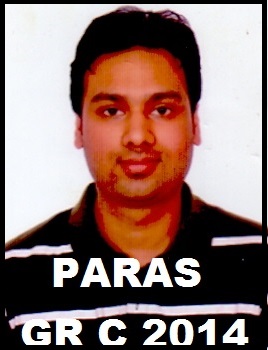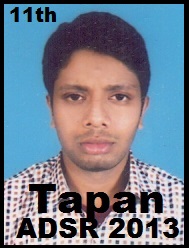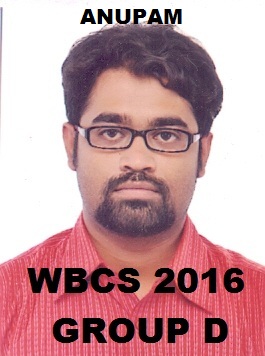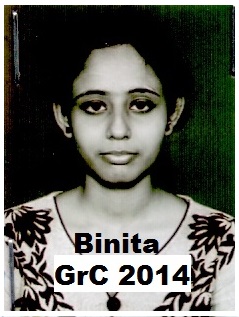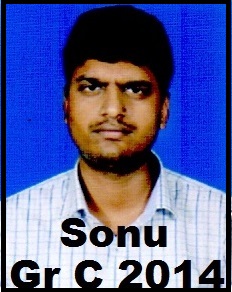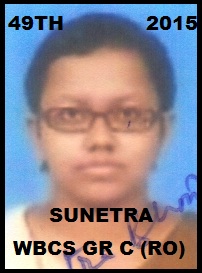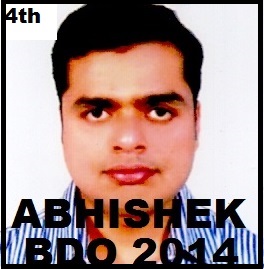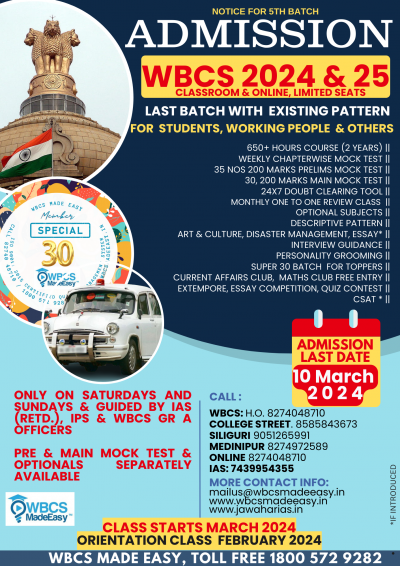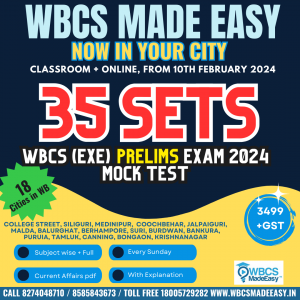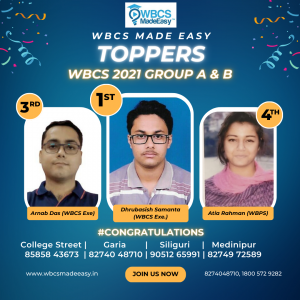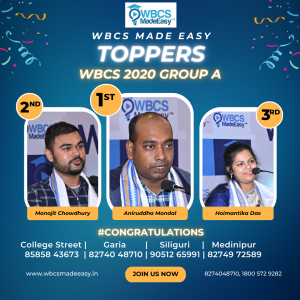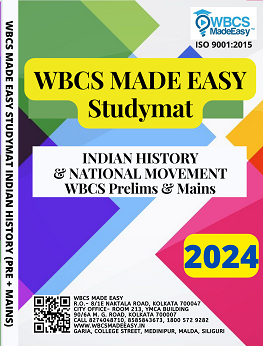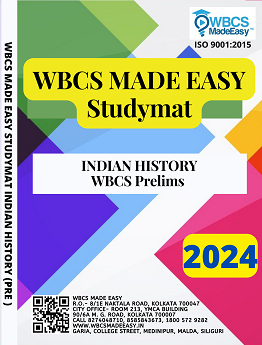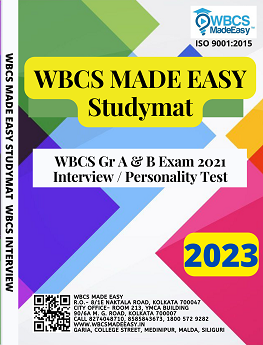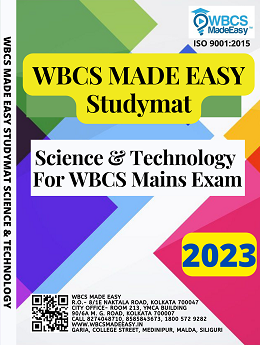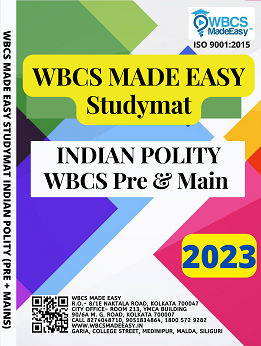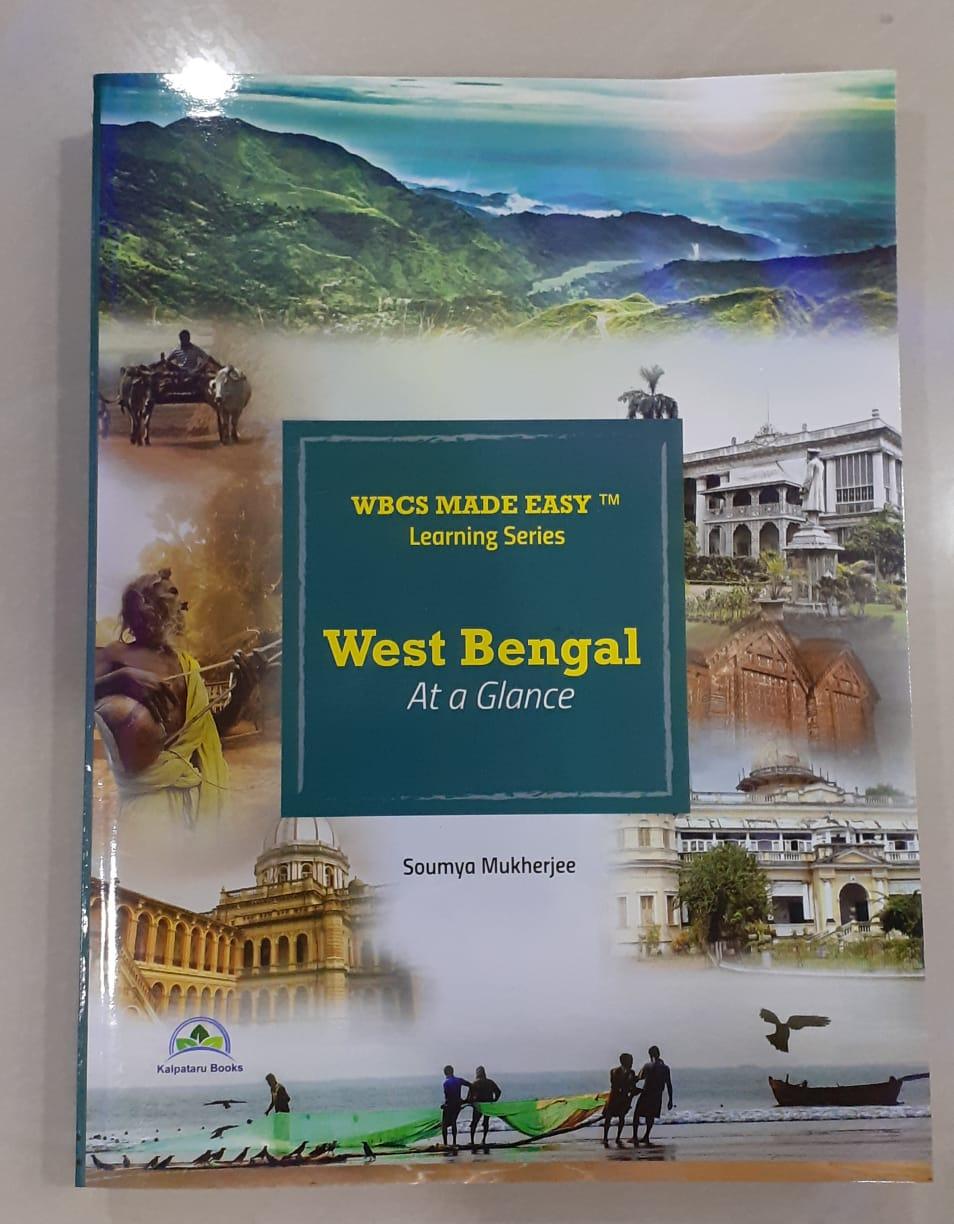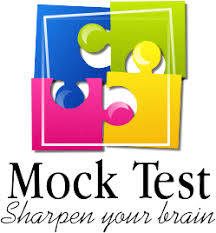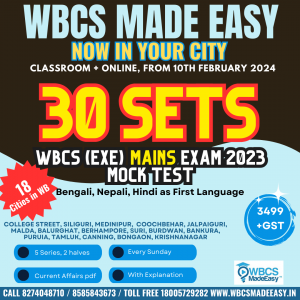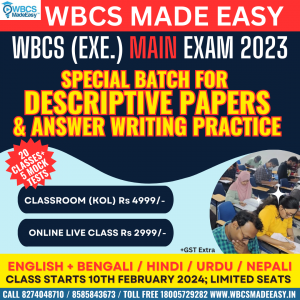W.B.C.S Main 2014 Optional Question Paper Commerce And Accountancy.
WBCS মেইনস ২০১৪ ঐচ্ছিক প্রশ্নপত্র বাণিজ্য এবং হিসাবরক্ষণ।
W.B.C.S Main 2014 Optional Question Paper Commerce And Accountancy paper 1
Group-A .Continue Reading W.B.C.S Main 2014 Optional Question Paper Commerce And Accountancy.
1. (a) Outline the role of an Accountant is the society.
(b) When the change in Accounting Policy is recommended ? What are the requirements of Disclosure in case of change in Accounting Policy ?
(c) Z Co. Ltd. changed depreciation on its assets on SLM basis. For the year ended 31-03-2014, it changed to WDV basis. The impact of the change when computed from the date of the asset coming to use amounts to Rs. 20 lakhs being additional change.
Decide how it must be disclosed in Profit & Loss Account. Also discuss When such change in the method of depreciation can be adopted by an enterprise as per As-6.
(d) Develop the accounting equation from the following information :
| Particulars | April 01,2013 | March 31, 2014 |
| Capital | 1,00,000 | ? |
| 12% Bank Loan | 1,00,000 | 1,00,000 |
| Creditors | 75,000 | 70,000 |
| Fixed Assets | 1,25,000 | 1,10,000 |
| Debtors | 75,000 | 80,000 |
| Stock | 70,000 | 80,000 |
| Cash & Bank | 5,000 | 6,000 |
Find the profit for the year & the Balance sheet as on 31-03-2014. 4 + 8 + 12 + 16
2. (a) Machinery account of X. Ltd., showed debit balance of Rs. 32,400 on January 1, 2013, depreciation being provided at 10% on July 1, 2013, a part of the machinery purchased for Rs. 10,000 on January 2011 was sold for Rs.7,000 and on the same date a new machinery which cost Rs.20,000 was purchased. On December 31, 2013, the company decided to change the method of depreciation from w.d.v. method to straight line method with effect from 1 January, 2011, depreciation remaining at 10% p.a. Show machinery account for 2013.
(b) A merchant’s trial balance as on June 30, 2010 did not agree. The difference was put to Suspense Account. During the next tading period, the following errors were discovered:
(i) The total of the purchase book of one page, Rs.4,539 was carried forward for the next page as Rs.4593.
(ii) A sale of Rs.573 was entered in the Sales Book as Rs. 753 and posted to the credit of the customer.
(iii) A return to a creditor, Rs.51() was entered in the Returns Inword Book; however, the creditor’s account was correctly posted.
(iv) Cash received from C.Das Rs.620 was posted to the debit of G.Das.
(v) Goods worth Rs.840 were depatched to a customer before the close of the year but no invoice was made out.
(vi) Gilds worth Rs. 1,000 were sent on sale or return basis to a (customer and entered in the Sales Book. At the close of the year, the customer still had the option to return the goods. The sale price was 25% above cost.
You are required to give journal entries to rectify the errors in a way so as to show the current year’s profit or loss correctly. 24 + 16
3. From the following balances and information received from the books of Mr. Y on 31st March, 2013, prepare the Trading and Profit and Loss Account for the year ended on 31st March, 2013 and the Balance Sheet as on that date.
| Rs. | Rs. | ||
| Mr. Y’s Capital Account | 60,000 | Plant and Machinery | 18,000 |
| Depreciation on Plant & Machinery | 2,000 | Repairs to Plant | 1,600 |
| Wages | 28,000 | Salaries | 4,000 |
| Income Tax | 500 | Cash in Hand | 2,000 |
| Land | 24,500 | Depreciation on Building | 2,500 |
| Purchase loss returns | 1,23,500 | Sales | 2,49,000 |
| Bank Overdraft | 13,800 | Accrued Income | 1.500 |
| Salaries Outstadig | 2,000 | Bills Receivable | 30,000 |
| Bills Payable | 3,000 | Provision for Doubtful Debts | 6,000 |
| Bad Debts | 1,000 | Discount on purchases | 4,000 |
| Sundry Debtros | 35,000 | Sundry Creditors | 23,300 |
| Stock on hand on (1-4-2011) | 37,000 | Building | 50,000 |
Additional Information :
(a) Stock on 31st March was Rs. 30,000 (b) Write off Rs. 3000 bad debts and maintain a provision for doubtful debts at 5% on Sundry Debtors (c) Goods Costing Rs. 5,000. These were recorded as actual sales. The rate of gross profit was 1/6 th of sale, (d) Rs. 1,200 paid as rent of the office were debited to landlord’s Account and were in cluded in Sundry Debtors (e) General Manager is to be given Commission at 10% after charging the Commission of works manager and his own on net profits (f) Works Manger is to be given Commission at 5% after charging Commission of General Manager and his own on net profits. Such Commissions shall be calculated to the nearest multiple of a rupee. 12 + 12 + 16
Group-B
4. (a) X Ltd. offered 10,000 equity shares of Rs.100 each for subscription at a premimum of Rs, 20 per share payable as follows: on application Rs.10; on allotment Rs.40 (including premimum); on 1st call Rs.20; on 2nd call Rs.30 and on final call Rs.10. The company received applications for 12,000 shares and 10,000 share were allotted pro-rate. Holder of 400 shares failed to pay the 1st call and after due notice their shares were forfeitted. The amount payable on the 2nd call were paid in full, except that a holder of 200 shares failed to pay. 250 of the 400 shares forfeited were re-issued, credited with Rs. 80 paid for Rs.50 per share. The final Call was met in full including the arrears of the Second Call.
Show necessary Journal entries including Cash in the books of the Company,
(b) The capital structure of a company consists of 20,000 Equity Shares of Rs.10 each fully paid up and 1,000 8% Redeemable Preference Shares of Rs.100 each fully paid up. Undistributed reserve and surplus stood as: General Reserve Rs.80,000; Profit & Loss Account Rs. 10,000; Investment Allowance Reserve (out of whih Rs.5,000, not free for distribution as dividend) Rs. 10,000; Securities premium…. Rs. 12,000. Cash at Bank amounted to Rs. 98,000. Preference Shares are to be redeemed at a premium of 10% and for the purpose of redumption, the directors are empowered to make fresh issue of Equity Shares at per after utilising the undistributed reserve and surplus, subject to the condition that a sum of Rs.20,000 shall be retained in general reserve and which should not be utilised.
Pass the Journal Entries to give effect to the above arrangement. 24 + 16
5. (a) Select the best choice of complete the answer
(i) The total managerial remuneration payable by a Public Company to its directors and managers in respect of any financial year shall not exceed (a) 11% (b) 10% (c) 9%
(ii) Corporate Dividend Tax is payable if the dividend paid out of: (a) Current profit only (b) accumulated profit only (c) current profit or accumulated profit,
(iii) Corporate Divident Tax will be shown in the Profit & Loss Account as: (a) A chage against profit (b) an appropriation of profit (c) none of the above,
(iv) Every Balance Sheet and Profit & Loss Account of a Company shall comply with: (a) US GAAP (b) Indian Accounting standard (c) International Accounting Standard.
(v) As per schedule VI Part.l. The Balance Sheet of a company shall be in: (a) Horizontal form (b) Vertical form (c) Either in horizontal form or Vertical form.
(b) A Limited Company has a paid-up equity share capital of Rs.15,00,000 divided into 1,50,000 shares of Rs.10 each and 11% preference shares capital of Rs.5,00,000 divided into 5,000 shares of Rs.100 each. The balance of profit brought forward from the previous Balance Sheet was Rs.38,000.
The profit for the year ended on 31st March, 2013 amounted to Rs.5,80,000 after tax. The directors proposed a dividend of 24% on equity share capita, after the folloing provisions:
(i) Statutory minimum transfer to general reserves; and
(ii) Provisions of dividend on preference shares. You are required to prepare Profit & Loss Appropriation Account.
(c) The Managing Director of X Manufacturing Ltd. is entitled to a Commission of 5% on the profit before charging such Commission. The following details are available for the year ending 31st March, 2014
(i) Net profit before charging the Commission- Rs.31,70,000
(ii) Bad Debt during the year Rs.57,000
(iii) The following had been charged off against the profits as determined in (i) above
(a) Depreciation on fixed Assets Rs. 14,50,000 (calculated as per provision of sec. 350); (b) Provision for bad and doubtful debt Rs. 16,000.
Calculate Commission payable to Managing Director; 10 + 20 + 10
Group-C
6. (a) Define the following citings examples.
(i) Opportunity Cost (ii) Sunk Cost (iii) Differential Cost.
(b) Material X is used in the manufacture of product Y and several other products. Total yearly requirement of material X is 1,20,000 litres, used evenly over the year.
The cost of ordering stock and holdings stock are as follows:
(i) Order cost per order Rs.900
(ii) Holding cost per litre per annum Rs. 6.
A safety stock of 2,500 litres of material X is held and average lead time is 1.5 weeks.
Calculate for material X:
(i) Economic Order Quantity (ii) Re-order laid (assuming 1 year = 50 weeks (iii) Total cost of ordering stock (v) Total annual lost of holding stock.
(c) Reality Builders obtained a contract to construct a building for Rs.2.9 crores. Building work commenced on 1st October, and at the close of the financial year as on 31st March, the construction was still in progress. The following information is available:
(i) Gontractee paid Rs.1.2 crores being 80% of the amount as per supervisor’s certificate of work completed as on 3st March, 2014,
(ii) Total cost as per Contract Account after adjustment of closing work-in-progress was Rs.1.35 crores.
As a prudent acountant, determine the amount of profit. Reality Builders are justified in taking to the credit of their Profit & Loss Account. 12 + 14 + 14
7. (a) Calculate the P/E ratio, from the following:
| Rs. | |
| Equity share capital (Rs.20 each) | 50,00,000 |
| Resere and surplus | 5,00,000 |
| Secured loan at 15% | 25,00,000 |
| Unsecured loan at 12.5% | 10,00,000 |
| Fixed Assets | 30,00,000 |
| Investments | 5,00,000 |
| Operating Profit | 25,00,000 |
| Income Tax rate | 50% |
| Market price/Share | Rs.50. |
(b) Serve well Ltd. is a single product producer with P/V ratio of 40% for the product during the current year. Due to increasing competition, it is believed that the price will have to be reduced by 10% in the next year. By what percentage sales value and sales quantity should increase so that Serve well Ltd. earns same profit.
(c) A company using standard costing system presents the following information for the budget period :
Budgeted fixed overhead=Rs.5,00,000
Overheads are recovered on the basis of stundard machine hours. The company had budgeted for 1,00,000 machine hours for the year. During the budget period the company used 1,10,000 machine hours while it should have used 95,000 machine hours for actual output.
Actual fixed overheads were Rs.4,70,000.
Calculate the following variances:
(i) Fixed overheads cost variance,
(ii) Fixed overheads expenditure variance.
(iii) Fixed overheads volume varience. 12 + 14 + 14
Group-D
8. (a) How would you distinguish between Tax Evasion and Tax Avoidance,
(b) Mr. A and Mrs. B came to India on 15th October, 2013 for avisit for 7months. Both of them are Indian citizens. In the earlier yars, they were in India as follows:
Year Mr.A Mrs.B
2012-13 ‘ 240 days 365 days
2011-12 340 days 20 days
2010-11 NIL 15 days
2009-10 118 days 120 days
Find out the residential status of Mr. A and Mrs. B for the A.Y. 2013-14.
(c) Mr. A receives the following salary and parquisites during the previous year 2013-14: Mr. A joined the company on 1-10-2010 in the scale of Rs.8000-200-9000; he received city compensatory allowance Rs.4000 p.m and entertainment allowances Rs.750 p.m. He and his employer both contributed 12% of salary to RPF. Interest credited to the said fund 11.5% Rs.2,300. He has his own car (having cubic capacity of engine more than 1.6 litres) which he both for official and privae purpose.
Entire expenses of Rs.34,000 including driver’s salary borne by the employer. Mr, Y is provided with the following benefits by his own employer:
(i) He is provided with free lunch during office hours in office @Rs.60 per lunch, assuming there are 260 working days in the year.
(ii) He purchased goods for personal use for Rs. 17,500 on credit card and the entire payment was made by his employer,
(iii) He was granted interest free loan of Rs. 3,50,000 on 1-6-2013 for purchase of a flat and Rs.20,000 for purchase of a colour television. Interest charged by S.B.I. 10.25% for housing loan.
(iv) He went on a official tour for 3 days and extended it by further 3 days for vacation. Expenses of Rs.6,000 for the entire tour was paid by his employer.
(v) Employer made a gift of Rs.9,000 to Mr. A on 25th anniversary of the Company.
(vi) He incurred club expenses of Rs.20,000 which was paid by his employer who recovered Rs.5,000 from him in this connection.
(vii) He is provided with a mobile phone both for official and private purpose. Entire expenses of Rs. 10,000 borne by the employer.
(viii) He is allowed to use a Laptop (costing Rs.l,10,000) and Air Conditioner (costing Rs.90,000) provided by his employer.
(ix) employer transferred a car to Mr. Y for Rs.l,00,000 on 1-10-2013. The car was purchased on 1-10-2011 for Rs.3,50,000.
Compute the income from salaries for Mr. A for the assesment year 2014-15. 6 + 14 + 20
9. Mr. Z has occupied three houses for his residential purpose, the particulars of which are :
| House I Rs. | House II Rs. | House III Rs. | |
| Standard rent under | |||
| Rent Control Act. | 16,000 | 21,000 | 36,500 |
| Municipal value | 11,000 | 31,000 | 30,000 |
| Fair rent | 18,000 | 28,000 – | 35,000 |
| Municipal tax paid | 1,200 | 2,400 | 3,600 |
| Repairs | NIL | NIL | 200 |
| Insurance Premium | |||
| paid during 2012-13 | 1,100 | 1,400 | ___ |
| Insurance Premium | |||
| due but outstanding | |||
| on 31st March, 2013 | _ | _ | 700 |
| Ground rent | 800 | .__ | 3,000 |
Z borrows Rs 40,000 @20% p.a. for construction of House III (Date of borrowing 1st June, 2008, date of repayment of loan 10th May, 2014).
Construction of all house is completed on 1st May, 2011. Determine the Taxabel Income of Mr. Z for the Assessment year 2014-15 on the assumption that his income from other sources is Rs. 15,000. 40
Group-E
10. (a) When is an inter-State sales exempt from Central Sales Tax ?
(b) Total inter-State Sale for the financial year 201-2014 of X Ltd. is Rs. 1,50,70,000 which consists of the following :
1% CST 91,50,000
2% CST 59,20,000
Out of the goods sold for Rs. 1,50,000 on July 16, 2013 that were liable to SCT @1% goods worth Rs.50,000 were returned on December 12, 2013 and goods worth Rs.1,00,000 were returned on February 1, 2014. A buyer to whom goods worth Rs.55,000 carrying 2% CST was despatched on April 16, 2013 rejected goods and the same were received back on November 15, 2013.
Compute the taxable turnover and tax liability of X Ltd. I all the relevant forms have been received.
(c) Mr. A purchase Raw Materials from X and Y for manufacturing goods. Mr. A sales goods to seller Mr. Z. Mr. Z sales goods to C Retailer, who sales goods to customer.
Calculate the amount of VAT collected by Govt, from the following particulars :
Based on the fact that Y charges VAT @5% and other sailers charged VAT @14.5%.
Followings are the price without VAT :
(i) Raw materials supplied by :
X to A Rs.5,000
Y to A Rs.8,000
(ii) Manufacture goods sold
A to Z Rs. 18,000
Z to C Rs.25,000
C to customer Rs.30,000 8 + 16 + 16
W.B.C.S Main 2014 Optional Question Paper Commerce And Accountancy paper 2
Group-A
Answer question no.l and any one from the rest.
1. (a) State the disclosure requirements during the Book Building process as specified by SEBI. 16
(b) Describe the role played by LICI in mobilizing the life insurance market in India. 16
(c) Write notes on : Bills of Exchange, Convertible Debentures. 8
2. (a) What do you mean by Commercial Paper (CP) ? 8
(b) Who are the participants in the CP market ? 12
(c) What is meant by a Right Issue ? 12
3. (a) Differentiate between Primary and Secondary Market segmentation of Indian Capital Market. 16
4. (a) State the importance of RBI’s Monetary Policy in the Indian Financial System. 24
(b) Write notes on : Bonus shares, Warrants. 8
Group-B
Answer Any two questions.
5. (a) Under what circumstances the doctrine of Supervening Impossibility is not applicable ?
(b) State the rights of consumers as per the Consumer Protection Act. 1986. 16 + 16
6. (a) Which of the institutions are regarded as “Public Financial Institutions” under the Companies Act. 1956 ? 8
(b) Write note on “Voting Rights” of member. 24
7. (a) State the types of debentures which may be issued by a public company. 24
(b) Write a note on “Debenture Trustee”. 8
8. (a) What do you mean by industrial disputes ?
(b) What do you mean by “Counter offer” ?
(c) Distinguish between “Award” and “Settlement” under the Industrial Disputes Act. 1947. 10 + 10 + 12
Group-C
Answer any one question
9. (a) How should an auditor differentiate between depreciation and depletion ? 8
(b) What do you mean by depreciable assets ? 8
(c) State the “methods of depreciation used by Indian Companies. When can a company change its method of depreciation ? 16
10. (a) What is the liability of an auditor to point out in his report that dividend is paid out of Capital ? 12
(b) State the procedure of appointment of the first auditor by a company. 8
(c) What are the different types of voucher an auditor should check and verify ? 12
Group-D
Answer any one question
11. (a) Enumerate the sources of demotivation in a corporate set-ting.
(b) Critically describe the “hierarchy of needs” theory propounded by Abraham Maslow. 12 + 20
12. (a) How do groups develop in an organization ? 12
(b) What do you mean by “group dynamics” ? 10
(c) Narrate the effectiveness of a matrix organization. 10
Our own publications are available at our webstore (click here).
For Guidance of WBCS (Exe.) Etc. Preliminary , Main Exam and Interview, Study Mat, Mock Test, Guided by WBCS Gr A Officers , Online and Classroom, Call 9674493673, or mail us at – mailus@wbcsmadeeasy.in
Visit our you tube channel WBCSMadeEasy™ You tube Channel
Please subscribe here to get all future updates on this post/page/category/website


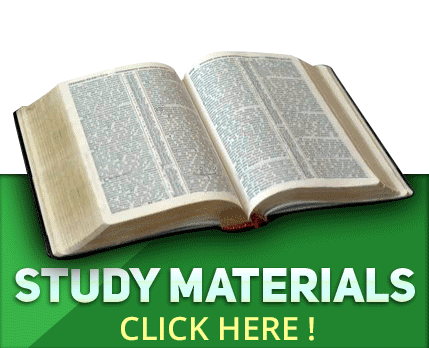
 +919674493673
+919674493673  mailus@wbcsmadeeasy.in
mailus@wbcsmadeeasy.in


